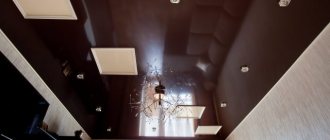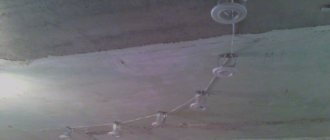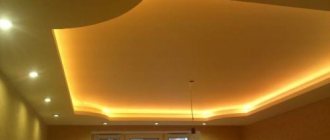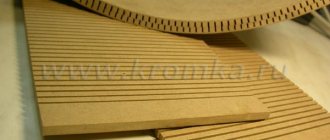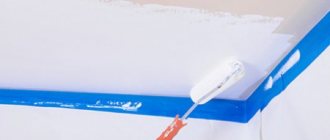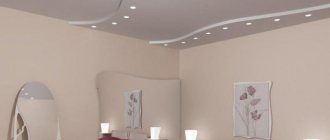Since installing ceiling structures made of PVC or polyester fabrics is a rather complicated process, many people think that removing the film is also difficult. This assertion is unfounded. Knowing the principle and technology of fastening, you can quickly dismantle suspended ceilings at home, even alone.
Clients are given a certificate of work completed, which indicates the type of film (fabric) and type of installation. This will allow you to dismantle the suspended ceiling with your own hands in a very short time.
Reasons and purpose of dismantling
The scheme of work directly depends on why it is necessary to remove the ceiling, and most importantly, whether it is planned to be reused. If the design is not conceptually satisfactory, and you decide to update the interior with new building materials (plaster, drywall, etc.), then you can remove the ceiling yourself and without special precautions.
Do-it-yourself dismantling of a suspended ceiling – Photo 2
It comes to the point that cuts are made in the film or fabric along the perimeter, and the remaining pieces are removed along with the profile.
Do-it-yourself dismantling of a suspended ceiling – Photo 3
If you need to preserve the canvas, or plan to dismantle part of it (in case of flooding of the apartment, when inserting decorative elements and additional lamps), it is important to take into account the design features:
- fastening method,
- type of canvas,
- presence of lighting elements,
- additional external and internal corners, bent profile.
To achieve successful dismantling, it is necessary to determine the type of fastening system.
Harpoon fastening
Used only for PVC coating. The fastener is very convenient because it allows you to disassemble the structure many times without damaging the panel. They start removing the film from the corner. Actions are carried out in the following sequence:
- If the joint is covered with decorative elements, remove them.
- Turn on the heat gun and raise the temperature in the room. This is necessary for the film to heat up and stretch. The tension will decrease and the mount can be disassembled. We heat the film from the center to the corners.
- Use a screwdriver to press out the harpoon. Carefully insert the spatula into the crack and lift the harpoon. We move the tool left and right, thereby pressing the fastener away from the baguette. We do the same on the opposite wall.
- Pull the spatula down, releasing the panel from the retainer. Moving the tool along the profile, we continue to remove the film.
If the covering is subsequently intended to be pulled back, it must not be deformed.
[custom_ads_shortcode2]
Dismantling instructions, depending on the type of suspended ceiling fastening
Today, there are 3 types of fasteners for installing PVC film or polyester fabric as a finishing material:
- Beading – mounted using wedges (cams).
- Clip-on – for woven fabrics, without additional fasteners.
- Harpoon - only for film coating.
The last method is the most common, as it is easy to install and provides the possibility of reinstallation and repair in case of minor damage.
Do-it-yourself dismantling of a suspended ceiling – Photo 4
Dismantling a suspended ceiling with a harpoon fastening
The fastening device is extremely simple: a dense edge in the shape of a harpoon is soldered around the perimeter of the canvas, which is attached to a plastic profile, hooked with a “hook”. Suitable exclusively for installation of PVC film.
Do-it-yourself dismantling of a suspended ceiling – Photo 5
The main advantage of the technology is high reliability and reusability. However, factory preparation of the fabric (welding) requires more time and the lead time for completing the installation order at the customer’s site increases slightly.
Do-it-yourself dismantling takes place in 4 stages:
- It is necessary to remove the decorative plug and clear the ceiling of all lamps and decorative elements. Apart from the baguette (profile made of aluminum or plastic) and the standard fastening, nothing should hold the canvas.
Do-it-yourself dismantling of a suspended ceiling – Photo 6
- Before removal, you can warm up the mount with a hairdryer or a fan heater, but the canvas can also be removed at room temperature, only with much greater effort.
- Behind the plug (plinth) in the technological gap you can see the outer part of the harpoon. Having examined it along the entire perimeter, you will find the joint of the fasteners. In this place you need to act very carefully - if you pull unsuccessfully, the canvas may tear. It is better to start dismantling exactly from the joint, and remove the harpoon from both sides of it.
Do-it-yourself dismantling of a suspended ceiling – Photo 7
- A small section of the profile is bent using special spatulas and blades of a certain shape, and the edging is easily removed from the baguette by hand. The fastening is stronger in the corners; it is better to heat these areas. Any hair dryer is suitable for such purposes.
At home, you can disassemble the fastening using various available tools, including a construction spatula, a kitchen spatula or a dessert knife.
Video of dismantling a stretch ceiling with a harpoon fastening system
Wedge mounting system
Based on the self-clamping principle. The edge of the canvas is placed in a U-shaped wall molding and tightly clamped with a glazing bead (wedge). The excess is cut off, and masking tape is attached around the perimeter.
Do-it-yourself dismantling of a suspended ceiling – Photo 8
It is mainly used for mounting on fabric ceilings, but also works great with PVC (Cerutti). Effective only for seamless ceiling structures.
Do-it-yourself dismantling of a suspended ceiling – Photo 9
The advantage of the glazing bead system is its moderate cost, versatility, and ease of installation.
Do-it-yourself dismantling of a suspended ceiling – Photo 10
When dismantling the bead fastening, you need to remove the decorative tape, carefully pry up the wedges with a handy tool and remove them one by one. The canvas can be easily removed.
Clips (clothespins)
Used in fabric series of Clipso and Descor products. The profile is presented in the form of a kind of clothespin and does not require additional fasteners. One part of the clip is a stationary part of the profile, and the second bends to bring the stretch ceiling fabric inside. The fabric is pressed into the profile using a semicircular blade and is immediately pressed by the moving part of the clip.
Do-it-yourself dismantling of a suspended ceiling – Photo 11
Decorative overlays are not needed - the suspended ceiling is located close to the wall, without technological gaps.
Do-it-yourself dismantling of a suspended ceiling – Photo 12
To detach the fabric from the baguette, just press hard on the canvas near the wall. The moving part of the clip will move, releasing the edge of the fabric.
Methods of fastening structures
Regardless of the fixation method, installation of the suspension system begins with the installation of profiles. It is they who will subsequently hold the tension panel. Three methods are used to fix it:
- Harpoon. A special edge is welded along the edges of the canvas; its shape resembles a harpoon. The film is tucked into the profile, where the edge spreads out and holds the ceiling in place.
- Bead or wedge. The edges of the canvas are fixed in the profile with a special spacer element called a bead.
- Cam, also known as clip-on. The material is held by specially shaped elastic plates located inside the baguette.
[custom_ads_shortcode2]
Cases in which a suspended ceiling is dismantled
We looked at the main reasons earlier, let’s look at them in more detail. Let's find out when radical measures are needed and when you can get by with little cost.
Minor damage
Even very durable PVC film can be punctured or cut. The most common case is the cork breaking through during an unsuccessful opening of champagne.
If the part of the canvas that is located close to the edge is damaged, then after partial dismantling, the torn area is carefully cut out, not reaching 1 centimeter from the harpoon. The resulting cut is evenly glued with high-quality specialized glue to the edge near the harpoon, and it is inserted back into the baguette.
Do-it-yourself dismantling of a suspended ceiling – Photo 13
Breaks in a suspended ceiling with wedge fastening are much more difficult to hide or eliminate. If the fabric is torn along the baseboard, then the likelihood of restoration is very low. In the case of a gap from the wall to the center, or closer to the middle of the ceiling, the success rate in this matter increases.
Do-it-yourself dismantling of a suspended ceiling – Photo 14
The film or fabric is dismantled in accordance with the technology; a prudently stored piece of PVC film or the thinnest fiberglass fabric is glued to the gap. Large damages are sewn together with nylon threads (the aesthetic appearance of the ceiling can be greatly affected).
The resulting folds or sagging after repair can be easily eliminated by warming up the damaged area with a regular hair dryer. You can also use a household fan heater.
Large tears and sagging
Formed from sudden temperature changes or as a result of errors made during installation. If the suspended ceiling is sagging, then the best solution would be to call the installers of the company that did the installation. Upon presentation of the warranty card, professionals are required to correct the defect.
Do-it-yourself dismantling of a suspended ceiling – Photo 15
When damage is caused by a drop in air temperature to a critical value (turning off the heating in the house), or severe shrinkage of the building, and there is no money to replace the canvas, you can try two methods:
- Seal the tears on the reverse side with a piece of PVC cloth (it is better not to use fiberglass on large surfaces).
- Warm the sagging thoroughly with warm air. The canvas should return to its original state. Otherwise, the solution depends on the mounting method. It will not be possible to re-tension a canvas with a harpoon, but it is more likely to be secured into a clip or glazing bead profile.
However, with the harpoon method, you can also take a risk: cut off the entire harpoon around the perimeter, change the profile to glazing beads, and secure it. But this method is only suitable if the fabric or film is of sufficient size and there are no seams.
Large holes, especially in places where the pipe bypasses, are difficult to eliminate. In most cases, the blade needs to be replaced.
Do-it-yourself dismantling of a suspended ceiling – Photo 16
Fluid accumulation
The most common option is flooding by neighbors living on the floor above. Problems with a leaky roof are less common. In any case, the same effect occurs: the ceiling sags in places where water accumulates.
Do-it-yourself dismantling of a suspended ceiling – Photo 17
There are two solutions:
- Remove one of the lighting fixtures (if any), disconnect the hole in the ceiling from the guides, and carefully drain the water through it.
- Release a significant part of the canvas from the profile in the corner of the room (on the side farthest from the accumulation of liquid, so that it does not spill prematurely). Create a kind of “neck” like a jug, and gradually distill the liquid into it.
Attention! There are standard tips from experienced craftsmen that need to be taken into account:
- Before the procedure, turn off the power supply to the room.
- Take an assistant (or better yet, two).
- The container for collecting liquid from the ceiling should be twice as large as you originally thought.
Often the scale of the “tragedy” is assessed biasedly, a small bucket or basin is taken, and most of the water flows out. As a result, the room is flooded.
Do-it-yourself dismantling of a suspended ceiling – Photo 18
When there is no water left in the ceiling, the space above the suspended ceiling must be dried. It is advisable to remove the canvas completely. If this is not possible, you need to install a fan heater or a household gun until the moisture completely disappears.
All manipulations can be carried out independently only if you have re-installation skills. Otherwise, you will still have to call the experts.
Mold
The appearance of fungus inside the ceiling space inevitably leads to the dismantling and disposal of the stretch ceiling. A complete antiseptic treatment of the room is carried out, after which decorative finishing can be done again.
Appearance of spots
Stains on fabric polyester ceilings resulting from flooding cannot be washed with any detergents. However, there is an inexpensive way to correct the situation: you can paint the canvas over the entire area with acrylic paint with high covering power. As a rule, no traces of stains remain.
Without repainting, all that remains is to dismantle and replace the canvas.
Clip fastening
Designed for installation of low-tensile coatings, such as polymer-impregnated fabrics. A clip is a type of fastening into which the edge of the covering is tucked inside. To remove it yourself, you need to remove the edge from the lock. We begin dismantling from the middle of the wall.
At the junction of the ceiling and wall surfaces, press the panel. At the same time, carefully loosen the fastening with pliers or a screwdriver. The fixation of the fabric loosens and it can be removed from the clip.
We do everything carefully to preserve the canvas. You will need it for subsequent installation. True, this is only possible if the fabric was not cut too short during installation.
[custom_ads_shortcode1]
What is needed to remove a stretch ceiling?
It is possible to successfully release the film or fabric from the profile without damaging the attachment point or compromising the integrity of the coating only with complete heating of the entire area of the fabric.
Do-it-yourself dismantling of a suspended ceiling – Photo 19
“Cold” is also dismantled, but in this case there is a high risk of tearing the material!
Fold the stretch ceiling with the front side inward, minimizing the number of folds.
The list of tools depends on the type of fastener, but there are mandatory ones for all cases:
- construction knitted soft gloves,
- dismantling spatula and spatula (for harpoon fastening),
- construction spatula,
- ladder,
- heat gun.
Do-it-yourself dismantling of a suspended ceiling – Photo 20
If repairs to the material are necessary, you will also need a construction knife, superglue and a piece of canvas.
To move the structure to another place or temporarily dismantle it together with the baguette (when carrying out finishing work indoors), you will need an assistant and additional tools:
- mounting clothespins (a couple of assistants can replace them),
- screwdriver,
- needle nose pliers,
- screwdriver,
- screwdriver
Do-it-yourself dismantling of a suspended ceiling – Photo 21
At each stage, care is needed: both when working with the canvas and when removing the profile (especially plastic). One awkward movement or extra effort - and you have to buy a new baguette or repair the material.
Note: if the fabric is torn at a point, the puncture or tear area will be neatly hidden by a lamp or decorative item installed there.
Preparing the premises
The ceiling reupholstery is done in a pre-prepared room. Objects that can be damaged by high temperature are removed from the room (if a heat gun is used).
If water has accumulated on the suspended ceiling, it is enough to dismantle one part and drain it
Aquariums are removed from the room and pets are removed. You also need to remove any things that will interfere with your work. The lamp is removed from the suspended ceiling and put away in a safe place. You can remove the lamp yourself, but if the mounting is complicated, you need to contact an electrician. The ceiling plinth or masking tape is removed and removed.
When do you need professional help?
It is imperative to contact specialist installers if you plan to dismantle a complex multi-level tension structure with translucent inserts and an abundance of lamps on the ceiling.
Do-it-yourself dismantling of a suspended ceiling – Photo 22
is ready to provide professional support in such cases. We provide a guarantee on the canvas and the quality of the fasteners. Problems are resolved quickly and smoothly!
Fixation with glazing bead
Used for all types of ceilings. For dismantling, it is necessary to remove the fastening elements-beads from the profile. We offer step-by-step instructions.
- Heat the polyvinyl chloride until it softens. If the ceiling is fabric, this is not necessary.
- We take long-nose pliers or a bent screwdriver and very carefully open the profile.
- Place the spatula behind the glazing bead and pull it down. The fastener comes out of the groove and releases the panel.
As in the previous case, we secure it with clamps so as not to deform it.
[custom_ads_shortcode3]
How to use old canvas
Both fabric and polyvinyl chloride film can be useful in the household. There are a lot of video instructions on the Internet on how to create canopies from them yourself and much more.
Examples of uses: decorative flowers and other crafts made from glossy film, water-repellent packaging for anything, a white screen for a projector, shelter for greenhouse plants in the country; a moisture-retaining layer for a homemade pond, napkins or a washable tablecloth, a summer canopy, a durable shopping bag. The choice is limited only by your imagination.
To order suspended ceilings in Yekaterinburg, please contact. We promptly fulfill any order and guarantee the quality of our work.
Specifics of working with PVC material
As a rule, suspended ceilings are made from PVC film - this option is cheaper than fabric, easier to care for and easier to install. Polyvinyl chloride film is very elastic, durable, and environmentally friendly. In addition, when heated to 60℃, PVC becomes even more elastic and can be stretched. As the material cools, it becomes denser and contracts. This property of PVC is used to create a decorative and beautiful stretch ceiling. A special heat gun is used for the work.
Although PVC film is very difficult to tear, it is sensitive to cuts from sharp objects. In case of such damage, the coating will have to be completely replaced.
Bead wedge system
We remove the decorative insert, then to free the tip of the bead, very carefully using the prepared staple, slightly bend the aluminum profile. The next step is to remove the bead using a curved screwdriver or other tool convenient for you; you also need to act very carefully. After stretching, you can release the required part of the canvas from the baguette. If a wedge was used instead of a bead, it will be somewhat easier to release and remove it.
[custom_ads_shortcode1]
Harpoon system
When dismantling ceilings with harpoon-type fastenings, work should begin from the corner of the room. If there is a decorative insert, remove it and carefully use pliers to pull out the canvas by the harpoon. With pliers we grab the harpoon, and not the surface of the canvas itself. Next, after part of the film has been removed, we use our hands to remove the canvas from the baguette, so as not to leave marks on the heated plastic; it is best to use work gloves.
[custom_ads_shortcode3]
